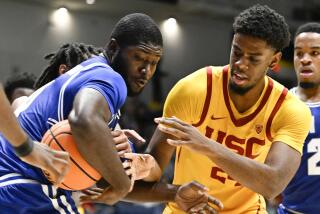Seton Hall Is Up From Rock Botton
This week marks an anniversary of sorts for the Seton Hall basketball program. But don’t expect any balloons or streamers on the South Orange, N.J., campus. And don’t expect any teary speeches from Pirates Coach P.J. Carlesimo.
It is the kind of anniversary you try to forget.
“We had hit rock-bottom,” said Athletic Director Larry Keating.
It was a year ago this week that Seton Hall blew second-half leads and lost to Syracuse and St. John’s at the Brendan Byrne Arena, falling to 2-6 in the Big East Conference and out of favor with the ever-patient Pirate fans.
Carlesimo started getting booed at home games. The parents of his players were subjected to such abuse in the Meadowlands that they had to change their seats.
And then came a story in the Seton Hall student newspaper, saying that the school senate was calling for Carlesimo’s contract not to be renewed at the end of season.
“I was just concerned from a won-lost standpoint,” recalled Carlesimo. “I was concerned with Larry Keating and (university President) Monsignor Petillo. I’m sure there was a faction that was unhappy with the job we were doing. It made for a good story, but to be quite honest, I didn’t read it.”
Said Keating, “It was a situation where P.J. was at the end of his contract. It was a little bit compounded by Providence, where Rick (Pitino) had turned it around quickly, even though he had a lot more to work with. Much of (criticism) was unrealistic and not understanding of what was going on.”
To the delight of those who painfully had followed Seton Hall’s basement existence in the Big East, the story had a happy ending. The Pirates won six of their next seven games, seven of their next nine, finished 8-8 in the league and became the first Seton Hall team to win more than 20 games since 1956.
They beat Georgetown in the opening round of the Big East tournament and went to the NCAA Tournament for the first time. And Carlesimo? He was named the league’s Coach of the Year and was given a five-year contract worth a reported $1.2 million. At the news conference to announce both, his words were choked with emotion.
“It all goes back to three years ago, when we were 15-14 and went to the NIT,” Carlesimo, 39, said recently. “We had always been very competitive. Of the 12 games we lost in the league, nine or 10 went down to the last few minutes. We felt we could play with anyone. We had to get over the next hump, learning how to win those close games.”
It appears Carlesimo’s team has crossed that barrier. The Pirates have an 18-2 record this season, a No. 10 ranking and the memory of last month’s 94-86 victory over the Hoyas.
But Carlesimo said the ride to the bottom of the Big East was much shorter than the ride to the top.
“Last year, we were a notch below,” said Carlesimo. “We’re not to the point where we’re in the upper echelon.”
As recently as five years ago, it appeared Seton Hall was not with the program in the Big East.
When Carlesimo arrived from Wagner College in 1982, he found that the basketball office consisted of a “table and a couple of chairs,” a gym with no side baskets, one full-time assistant and one part-timer and a recruiting budget that allowed him to make it across the George Washington Bridge a few times a year.
“When P.J. got there, he didn’t have any Big East players, maybe one,” said Syracuse Coach Jim Boeheim. “He had to have a lot of patience. Fortunately, the school didn’t run out of patience too soon.”
What helped turn it around for Seton Hall was the friendly yet firm persuasion of Big East Commissioner Dave Gavitt and the rest of the league’s founding fathers. Their message to the school’s administration was clear: Shape up.
“Back then, the feeling was that, for Seton Hall to be a viable member of this league, they had to step up and do something,” said associate commissioner Mike Tranghese. “From that day on, they planned and implemented it. I don’t know what would have happened had they not done it. But it’s light years away from where it was. It’s one of the significant accomplishments in the league during the first 10 years.”
Now comes the tough part: sustaining that success.
Seton Hall, despite playing home games at a pro arena, doesn’t have the on-campus attraction of the Carrier Dome in Syracuse. It doesn’t have the tradition of St. John’s. It can’t wave a national championship banner, as Georgetown and Villanova can.
Nor do the Pirates have the blue-chip players. This year’s team, which includes a dozen juniors and seniors, is built around point guard Gerald Greene and forward Andrew Gaze, a 23-year-old member of the Australian Olympic team. The underclass is nearly non-existent, and Seton Hall has signed three players for next year, none of them on anybody’s All-America lists.
“We’ve come close with a couple of people that went to other Big East schools, but we’ve yet to establish that we can compete head to head,” said Carlesimo, who wants to prove that nice guys can finish first as well as last.
More to Read
Go beyond the scoreboard
Get the latest on L.A.'s teams in the daily Sports Report newsletter.
You may occasionally receive promotional content from the Los Angeles Times.










